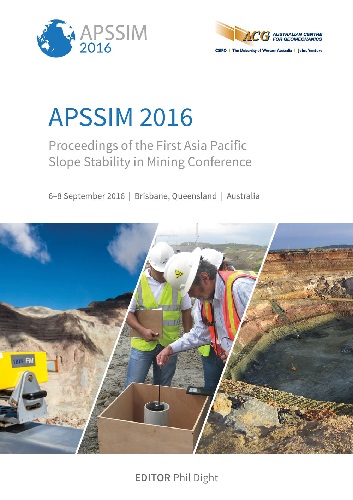Rock slope stability risks

|
Authors: Baczynski, NRP |
DOI https://doi.org/10.36487/ACG_rep/1604_30_Baczynski
Cite As:
Baczynski, NRP 2016, 'Rock slope stability risks', in PM Dight (ed.), APSSIM 2016: Proceedings of the First Asia Pacific Slope Stability in Mining Conference, Australian Centre for Geomechanics, Perth, pp. 469-484, https://doi.org/10.36487/ACG_rep/1604_30_Baczynski
Abstract:
The methodology and factors that impact on rock mass slope stability risks are data collection, processing, reliability and the partitioning of data into domains. This paper discusses the development of statistical models for geological defect and rock mass attributes. Kinematic stability analyses are mandatory to identify slope failure modes. The Hoek–Brown method is commonly used to assess rock mass strength, but sometimes over-estimates the strength. The author advocates a Step-Path method, where directional rock mass strength is considered. Sampling Theory relationship between mapping-window sizes, lengths of failure paths through slopes and strength variability is described in this paper. The Rosenblueth matrix is used to develop statistical strength parameters and assess stability risks. An equation is provided for the combining of stability risks computed for several failure modes in different slopes. In the presented case study, the Step-Path strength yields a 30% lower Factor of Safety than the Hoek–Brown strength. Sampling Theory adjustments result in a five-fold decrease in the statistical spread of Factors of Safety and a significant decrease in the estimated stability risks.
Keywords: slope stability risks, path-length dependent strength variability along failure paths, sampling theory
References:
Baczynski, NRP 2016, ‘Step-path method: impact of defect occurrence, cut-off and length on shear strength in rock slopes’, in PM Dight (ed.), Proceedings of the First Asia Pacific Slope Stability in Mining Conference, Australian Centre for Geomechanics, Perth, in press.
Baczynski, N, Marples, R, Tamplin, S & Choros, E 2001, ‘Application of slope stability risk design process to open cut mines’, R Doyle & J Moloney (eds), in Proceedings for Geological Hazards - The Impact on Coal Mining, Coalfield Geology Council of New South Wales and New South Wales Department of Mineral Resources, pp. 151–171.
Barton, N 1976, ‘The shear strength of rock and rock joints’, International Journal of Rock Mechanics and Mining Sciences & Geomechanics Abstracts, vol. 13, pp. 1–24.
Bieniawski, ZT 1989, Engineering Rock Mass Classifications, John Wiley & Sons, p. 251.
Hoek, E & Brown, ET 1980b, Underground Excavations in Rock, London Institution of Mining and Metallurgy, p. 527.
McMahon, BK 1985, ‘Geotechnical design in the face of uncertainty’, Australian Geomechanics Society E.H. Davies Memorial Lecture, Australian Geomechanics, pp. 13–19.
© Copyright 2025, Australian Centre for Geomechanics (ACG), The University of Western Australia. All rights reserved.
View copyright/legal information
Please direct any queries or error reports to repository-acg@uwa.edu.au
View copyright/legal information
Please direct any queries or error reports to repository-acg@uwa.edu.au